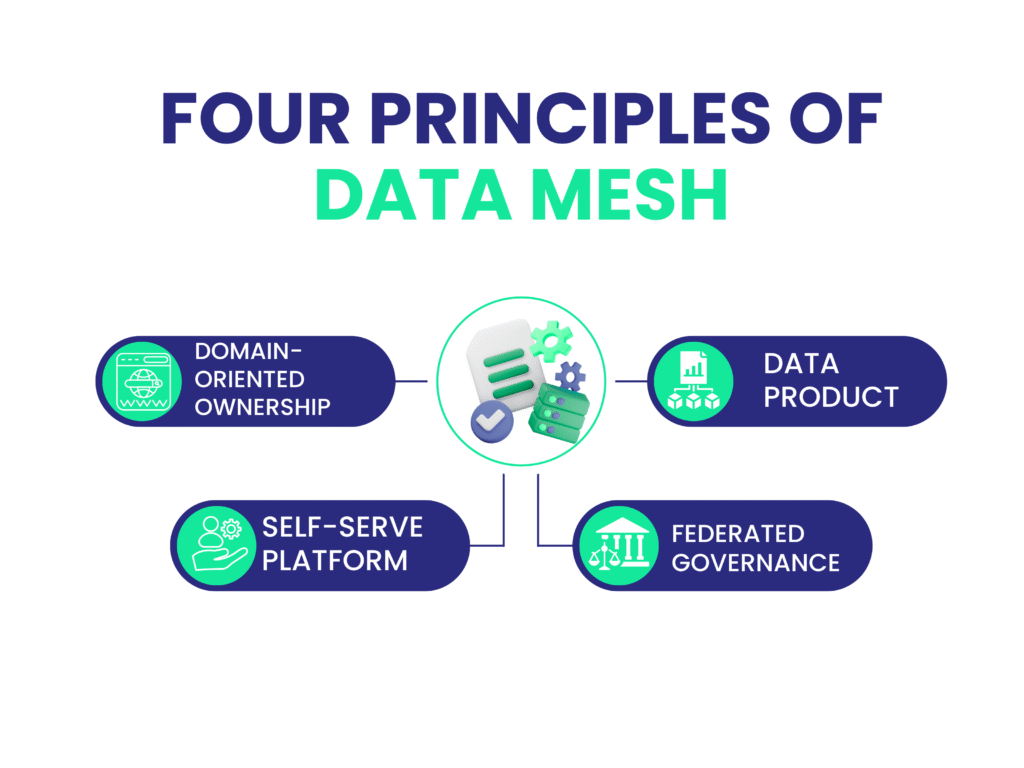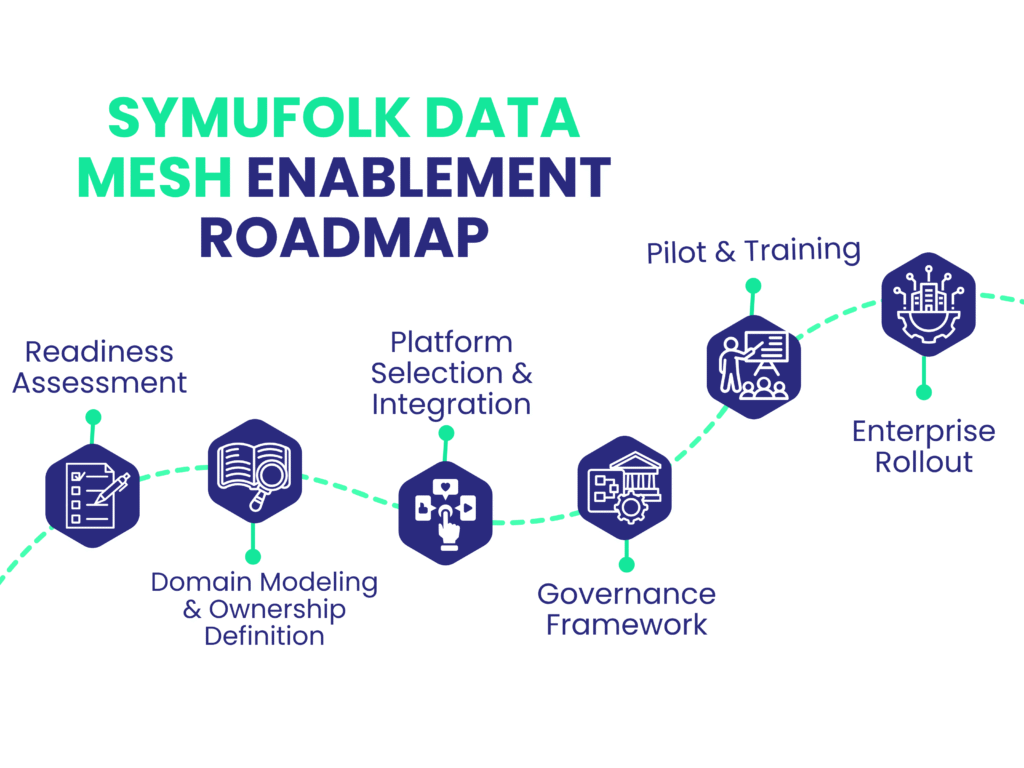Organizations worldwide are grappling with exploding data volumes, fragmented pipelines, and the constant pressure to turn raw information into actionable insights. Traditional centralized architectures, data lakes and monolithic warehouses, are reaching their limits. As a response, data mesh has emerged as a transformative framework designed to unlock agility, scale, and trust.
At Symufolk, we’ve supported companies across industries in building resilient, scalable data ecosystems. In this guide, we’ll break down exactly how to implement data mesh, why it matters in 2025, the essential tools you’ll need, and proven best practices to avoid costly pitfalls.
What Is Data Mesh?
Data mesh is a modern approach to data architecture that decentralizes ownership and treats data as a product. Instead of a single central team handling ingestion, transformation, and serving, each business domain—like Marketing, Sales, or Supply Chain—takes end-to-end responsibility for its data pipelines.
This paradigm shift rests on four core data mesh principles:
- Domain-Oriented Ownership: Each domain builds and maintains its data products.
- Data as a Product: Data assets have product owners, SLAs, and well-defined consumers.
- Self-Serve Data Platform: Centralized tooling empowers domains to deliver and consume data independently.
- Federated Computational Governance: Policies and standards are enforced consistently across domains.
Symufolk specializes in guiding enterprises through these principles, ensuring that your architecture balances innovation with compliance from day one.
Why Adopt Data Mesh in 2025?
Moving to a data mesh architecture isn’t simply a technical upgrade—it’s a cultural and organizational transformation. In 2025, the urgency to modernize data management is only intensifying as:
- Data volumes grow exponentially with IoT and AI adoption.
- Decision-makers expect near real-time analytics.
- Regulations demand tighter governance and traceability.
Data mesh implementation helps you address these challenges by:
- Accelerating time-to-insight for every domain.
- Scaling data production without overloading central teams.
- Improving data quality through domain accountability.
- Enabling trusted self-service access to consistent data.
Symufolk brings a proven methodology to assess readiness, design domain models, and establish the right governance framework tailored to your industry.
How to Implement Data Mesh: A Practical Roadmap
Transitioning to data mesh requires strategic planning and incremental execution. Here’s how Symufolk approaches data mesh implementation with clients:
1. Establish Domain-Oriented Ownership
The first step is to define clear data domains aligned with your business structure. Each domain should:
- Map to key business capabilities (e.g., Customer Engagement, Product Lifecycle).
- Own ingestion, processing, and serving pipelines.
- Appoint a data product owner accountable for outcomes.
Symufolk can facilitate domain discovery workshops, helping you structure ownership models that fit your workflows and culture.
2. Design Data as a Product
Treating data as a product means delivering high-quality, discoverable assets with clear contracts and SLAs. Each data product must include:
- Well-defined metadata, documentation, and lineage.
- Versioning and freshness guarantees.
- Clear access policies and usage metrics.
For example, a Customer domain might deliver real-time customer profile updates as an API with guaranteed latency and compliance logs.
Symufolk’s experience in data product design ensures your teams build assets that are trusted and reusable across the enterprise.
3. Build a Self-Serve Data Platform
A robust self-serve platform is the backbone of any data mesh. This platform empowers domains to:
- Provision infrastructure with infrastructure-as-code templates.
- Ingest and transform data with pre-configured pipelines.
- Monitor quality and compliance automatically.
Symufolk partners with leading providers such as Databricks, Snowflake, and AWS, helping you integrate tools that fit your cloud ecosystem. We also customize self-service portals so that teams can operate independently without compromising security.
4. Implement Federated Computational Governance
Governance is often where data mesh initiatives stall. You need to balance autonomy with uniform policies for:
- Data security and encryption.
- Regulatory compliance (GDPR, HIPAA, CCPA).
- Access control and audit trails.
Using policy-as-code tools like OPA, Immuta, and AWS Lake Formation, Symufolk helps automate governance, ensuring that compliance is embedded into every data product lifecycle without adding friction.
5. Foster a Culture of Enablement
Data mesh is as much about people as technology. For sustainable success, you must invest in:
- Training for data product thinking and tooling proficiency.
- Clear incentives for data stewardship.
- Collaboration practices that connect producers with consumers.
Symufolk supports this cultural shift by designing enablement programs, onboarding playbooks, and domain-specific training so your teams are fully equipped to own their data products confidently.
Essential Data Mesh Tools and Platforms for 2025
Building a modern data mesh framework requires integrating a stack of specialized tools. Here are some leading solutions Symufolk implements with clients:
- Data Catalogs & Discovery: Alation, Collibra, Amundsen
- Data Pipelines & Orchestration: Apache Airflow, Dagster, Prefect
- Data Quality Monitoring: Monte Carlo, Great Expectations
- Access and Policy Enforcement: Immuta, OPA
- Observability & Lineage: Datadog, OpenLineage
- Infrastructure Automation: Terraform, Pulumi
Symufolk helps you evaluate, deploy, and integrate these tools into cohesive, user-friendly self-service platforms.
Data Mesh Best Practices for 2025
Drawing on real-world experience, here are Symufolk’s recommended data mesh best practices:
- Start Small, Scale Fast: Pilot with 1–2 domains to validate your model and iterate.
- Invest in Enablement: Provide hands-on training and clear success criteria.
- Automate Governance: Policy-as-code reduces manual oversight and errors.
- Measure Outcomes: Use KPIs like time-to-insight, data product adoption, and data quality.
- Continuously Evolve: Refine domains, contracts, and tooling as your maturity grows.
Real-World Example: Data Mesh in Action
Consider a global retail chain that struggled with siloed analytics and slow insights. Working with Symufolk, the company:
- Defined six core data domains, including Customer, Inventory, and Supply Chain.
- Deployed a self-serve platform integrated with Databricks and Snowflake.
- Established data product SLAs with lineage tracking and automated policy enforcement.
- Trained over 300 domain team members on product thinking.
In less than a year, they reduced time-to-insight by 60%, increased data trust, and scaled to over 50 live data products—proving the power of data mesh in the real world.
How Symufolk Can Help
Implementing a data mesh architecture requires more than just tools. It demands:
- A clear vision anchored in business goals.
- A robust technology ecosystem.
- A culture that embraces product ownership.
At Symufolk, our team of data strategists, architects, and engineers helps organizations design, deploy, and scale data mesh frameworks end to end. Whether you’re planning a pilot or ready to roll out across domains, we’ll guide you every step of the way—from readiness assessment and platform engineering to governance automation and team enablement.
Conclusion
As we move deeper into 2025, data mesh is no longer a future aspiration, it’s a necessary foundation for modern data-driven organizations. By distributing ownership, treating data as a product, and empowering domains with the right platforms and governance, you can unlock the agility and scale your business demands.
If you’re ready to reimagine your data architecture, Symufolk is here to help you design a strategy that fits your vision and accelerate your path to a successful data mesh implementation.
Contact us today to explore how Symufolk can help you put data mesh into action and transform your data into a strategic asset.








